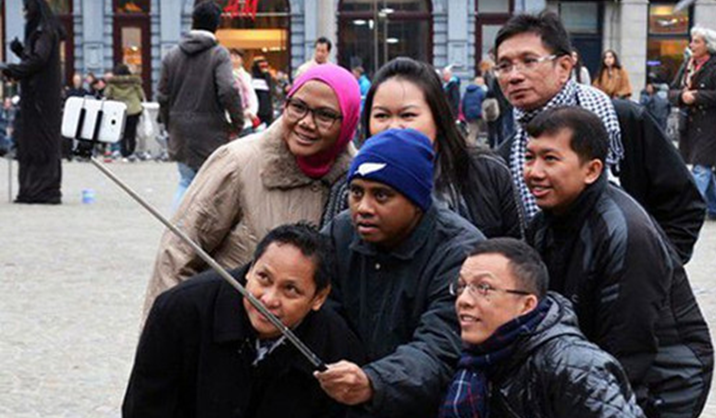看美国海关对“自拍杆”的归类
对于“自拍杆”这一神器,大家肯定不陌生,出去旅游、亲朋好友聚会,一定少不了这件宝贝。市面上自拍杆种类丰富多样,工作原理也不尽相同,笔者先来为大伙们简单介绍下如今市面上“自拍杆”的预归类。

第二种:带控制功能的伸缩杆+手机固定器:通过手机蓝牙搜索自拍杆配带的蓝牙信号,配对后,通过蓝牙遥控器来控制快门,这种自拍杆一般是用电池或者充电;
第三种:带控制功能的伸缩杆+手机固定器:杆子上配有一个插入手机的耳机孔的线,只要将线插上手机,按杆子上的按钮就可以拍照了,这种自拍杆不需电池,不需充电;
第四种:不带控制功能的伸缩杆+手机固定器+无线遥控器:无线远程控制手机拍摄功能,利用蓝牙无线技术,进行的一种远程控制,无线遥控器需要电池或者充电。
说起以上四种自拍杆,工作原理的不同,因此拍摄效果相互之间也有差异。有些持有第三种自拍杆的朋友,经常会抱怨,当拍摄视频时,无法录制视频的声音,只能获得无声音视频;但是对于持有第二种自拍杆的朋友又经常会遇到自拍杆电池不够用需要定时充电的麻烦。
对于目前比较新颖的产品,我国尚未有很全的归类指引,再加之机电类产品的归类,理解不同就会有不同的归类思路和结果,因此笔者查询了美国海关对于“自拍杆”归类的认定,分享给大家,以扩展各位伙伴的归类思路:
对于第一种,笔者参照了美国海关Ruling:N268229
The item under consideration is identified as the Bratz Selfie Stick with a lip attachment. The product consists of an aluminum telescoping pole with a silicon grip and can extend to approximately 16.5 inches in length. The pole has a plastic platform with a ¼ inch universal screw located at the top. The attachment consists of a lip shaped plastic phone holder with a phone mount that has a ¼ inch universal thread insert at the bottom that can be mounted directly onto the screw at the top of the selfie stick. The stick can also be used without the attachment. A camera that is designed to be attached to a selfie stick can be mounted directly onto the screw at
the top of the platform. The selfie stick allows the user to take photos with their smart phone or camera in hard to reach locations at various angles.
The Bratz Selfie Stick in question is a composite article that consists of aluminum and plastic components that are classified in different headings. Classification of merchandise under the Harmonized Tariff Schedule of the United States (HTSUS) is in accordance with the General Rules of Interpretation (GRIs), taken in order. GRI 1 provides that classification shall be determined according to the terms of the headings and any relative section or chapter notes. Since no one heading in the tariff schedules covers the aluminum and plastic components of the Bratz Selfie Stick with a lip attachment in combination, GRI 1 cannot be used as a basis for classification. GRI 3(b) provides that mixtures, composite goods consisting of different materials or made up of different components, and goods put up in sets for retail sale shall be classified as if they consisted of the material or component which gives them their essential character. As the Bratz Selfie Stick under consideration is a composite good, we must apply rule GRI 3(b), which provides that composite goods are to be classified according to the component that gives the goods their essential character. EN VIII to GRI 3(b) explains that “the factor which determines essential character will vary as between different kinds of goods. It may, for example, be determined by the nature of the material or component, its bulk, quantity, weight or the use of the goods.” We must determine whether the aluminum or plastic components impart the essential character to the article in question. It is the role of the constituent materials or components in relation to the use of the good that imparts the essential character. In this case, extending the aluminum pole allows the user to take photos from hard to reach places. Therefore, it is the opinion of this office that the aluminum component imparts the essential character to the selfie stick. In accordance with GRI 3(b), the Bratz Selfie Stick will be classifiable in heading 7616, HTSUS, which provides for other articles of aluminum. The applicable subheading for the Bratz Selfie Stick with a lip attachment will be 7616.99.5090
以上归类依据说明了归类总规则一必须优先考虑,当总规则一不适用时,才逐一考虑总规则二,总规则三的(一),(二),(三);很显然本商品总规则一并不能解决归类问题,因此考虑用总规则三,鉴于本商品是复合材质的商品,且没有列名税号,故考虑用总规则三(二)确定其基本特征,从而确定其归类税号。在考虑基本特征时,可以通过产品的成分与组成、大小、数量、重量或用途确定。而对于本商品而言,美国海关认为基本特征时可以伸缩的铝杆,用来延伸到更高更远的地方进行拍摄。综上,美国海关采用归类总规则三(二)将本商品按照铝制品归入7616.99项下。
对于第二种和第三种自拍杆,笔者也寻找到相关的美观海关Ruling:N265045、N267144
N265045:
The item under consideration is referred to as a “selfie stick”. This device consists of a 13 inch stainless steel telescoping rod with a plastic mount for a smart phone on one end and a handle incorporating a momentary contact electrical switch (camera button) on the other. The electrical cable, which is connected to the camera button, runs up through the rod and exits at the top where it is fitted with a plug that fits into a phone’s audio jack. The telescoping rod can extend to a length of 42.5 inches, allowing a user to take photos at a distance while holding on to the selfie stick handle.
In use, a person would secure a smart phone to the adjustable mount, plug the selfie stick cable into the device’s audio jack, and take photos or videos by pressing the camera button located on the handle. We note that the selfie stick currently under review does not contain any batteries and derives it power from the mounted phone’s audio jack.
The classification of merchandise under the Harmonized Tariff Schedule of the United States (HTSUS) is governed by the General Rules of Interpretation ("GRIs"), taken in order. GRI 1 requires that classification be determined according to the terms of the headings and any relative section or chapter notes. In the event that goods cannot be classified solely on the basis of GRI
1, and if the heading and legal notes do not otherwise require, the remaining GRIs will be applied, in the order of their appearance.
Goods that are, prima facie, classifiable under two or more headings, are classifiable in accordance with GRI 3, HTSUS. GRI 3(a) states in part when two or more headings each refer to part only of the materials or substances contained in mixed or composite goods, those headings are to be regarded as equally specific, even if one heading gives a more precise description of the good. Goods classifiable under GRI 3(b) are classified as if they consisted of the material or component which gives them their essential character, which may be determined by the nature of the material or component, its bulk, quantity, weight or value, or by the role of a constituent material in relation to the use of the article. GRI 3(c) provides that when goods cannot be classified by reference to GRI 3(a) or 3(b), they are to be classified in the heading that occurs last in numerical order among those which equally merit consideration.
The product in question has two distinct features which warrant equal consideration: a device used to mount and hold a smart phone, which would be provided for in heading 8479, HTSUS, and to electrically activate the phone’s camera function, which would be provide for in heading 8543, HTSUS. This office finds that neither the mounting/positioning feature nor the electrical activation of the camera function implies the essential character of this device. GRI 3(c), HTSUS, states that in such circumstances the classification will be the heading that appears last in numerical order among those which equally merit consideration. In this particular case, the heading for the electrical activation appears last in numerical order.
以上所述商品为第三种,即杆子上配有一个插入手机的耳机孔的线,只要将线插上手机,按杆子上的按钮就可以拍照。根据美国海关分析,通过有线方式激活相机拍摄的功能属于第85章未列名的功能,因此将其归入了品目8543。
N267144:
This device consists of a stainless steel telescoping rod with an adjustable plastic mount for a mobile phone on one end, and a rubber/plastic handle that incorporates a momentary contact electrical switch (camera button) on the other. The selfie stick contains an electronic printed circuit board (PCB) with Bluetooth functionality to remotely operate the phone’s camera, and is imported with a short USB/micro cable. The telescoping rod can extend to a length of approximately 25 inches, allowing a user to take photos at a distance while holding on to the selfie stick handle.
In use, a person would secure a mobile phone to the adjustable mount and take photos or videos by pressing the camera button located on the handle. We note that the selfie stick currently under review derives its power from the Bluetooth technology. You question whether it’s the Bluetooth technology or the material composition of the selfie stick that imparts its essential character.
The classification of merchandise under the Harmonized Tariff Schedule of the United States (HTSUS) is governed by the General Rules of Interpretation ("GRIs"), taken in order. GRI 1 requires that classification be determined according to the terms of the headings and any relative section or chapter notes. In the event that goods cannot be classified solely on the basis of GRI
1, and if the heading and legal notes do not otherwise require, the remaining GRIs will be applied, in the order of their appearance.
Goods that are, prima facie, classifiable under two or more headings, are classifiable in accordance with GRI 3, HTSUS. GRI 3(a) states in part, when two or more headings each refer to part only of the materials or substances contained in mixed or composite goods, those headings are to be regarded as equally specific, even if one heading gives a more precise description of the good. Goods classifiable under GRI 3(b) are classified as if they consisted of the material or component which gives them their essential character, which may be determined by the nature of the material or component, its bulk, quantity, weight or value, or by the role of a constituent material in relation to the use of the article. GRI 3(c) provides that when goods cannot be classified by reference to GRI 3(a) or 3(b), they are to be classified in the heading that occurs last in numerical order among those which equally merit consideration.
The product in question has two distinct features which warrant equal consideration: a device used to mount and hold a mobile phone, which would be provided for in heading 8479, HTSUS, and the electrical activation of the phone’s camera function which would be provide for in heading 8543, HTSUS. This office finds that neither the mounting/positioning feature nor the electrical activation of the camera function implies the essential character of this device. GRI 3(c), HTSUS, states that in such circumstances the classification will be the heading that appears last in numerical order among those which equally merit consideration. In this particular case, the heading for the electrical activation appears last in numerical order.
The applicable subheading for the “selfie stick,” item GP-PICSTICK, will be 8543.70.9650, HTSUS
以上所述为第二种自拍杆,即通过手机蓝牙搜索自拍杆配带的蓝牙信号,配对后,通过蓝牙遥控器来控制快门进行拍摄。美国海关认为此种自拍杆同样属于85章未列名商品,因此还是归入了品目8543。
第四种自拍杆,是通过无线遥控的方式进行控制和拍摄,此种虽在美国Ruling上没有找到完全一致的,但有个Ruling也值得参考,N267084:
A sample of the “Bratz Selfie Stick + Jade” was received with your inquiry. The item consists of the “Bratz” doll Jade (a Cloe version will also be available), a telescoping “selfie stick” that extends to approximately 24” in length, a “Bratz” lip phone holder and a hand-held remote. The remote wirelessly controls the camera shutter of one’s smart phone once it is synched via Bluetooth. The “Bratz” doll measures approximately 11” in height and comes with a complete outfit including appropriately sized shoes, a pair of earrings, and a toy smart phone with case.
In your request you suggest that the items be classified together under the toy provision. Note 4 to Chapter 95 allows articles that are imported packaged together with toys for retail sale to be classified in heading 9503, Harmonized Tariff Schedule of the United States (HTSUS), provided that the combination of items do not constitute a set under GRI 3(b), and the combination has the essential character of toys. Also, for Note 4 to apply, the toy and non-toy item(s) must complement one another to the extent that together they can be used for “amusement, diversion or play” in order to possess “the essential character of toys.”
While the articles are imported packaged together, have components classified in multiple headings and do not constitute a set under GRI 3(b), the doll, selfie stick and remote do not complement one another for amusement purposes. While you state that children will pose with their fashion doll to take pictures using their selfie stick and remote with their smart phone, there is nothing to suggest that children will use these articles together with the doll for amusement purposes. Furthermore, with regards to Note 4, in order to meet the terms of this note the non-toy(s) items can include one or more items of minor importance. Based on the information supplied, the selfie stick and remote make up the majority of the value of the items, clearly making them more than just articles of minor importance. Therefore, these items do not meet the requirements of Note 4 to Chapter 95 and they will be classified separately. Only the “Bratz” doll and its accessories are toys. They are principally designed for the amusement of children 5 years of age and older.
……
The applicable subheading for the radio remote control device will be 8526.92.5000, HTSUS, which provides for Radar apparatus, radio navigational aid apparatus and radio remote control apparatus: Other: Radio remote control apparatus: Other. The rate of duty will be 4.9 percent ad valorem.
上述的Ruling为我们阐述了由玩具娃娃、自拍杆以及无线遥控构成的成套商品的归类问题。由于该套玩具并不符合95章章注四,即“除上述注释一另有规定的以外,品目95.03主要适用于该品目所列的物品与一项或多项其他货品组合而成的物品,只要这些物品为零售包装,且组合后具有玩具的基本特征。这些组合物品不能视为归类总规则三(二)所指的成套货品,如果单独报验,应归入其他品目。”本商品组合后,只有玩具娃娃以及娃娃的一些配饰可以算是有娱乐性,而自拍杆和无线遥控设备并非纯娱乐性;再者美国海关认为本商品各组成部件之间并无相互补足,因此只能将玩具娃娃、自拍杆及无线遥控设备分别归类。自拍杆与无线遥控必须是配合使用,故,美国Ruling最终将自拍杆与无线遥控设备一并归入品目8526项下。
通过查阅美国Ruling,各位是否已经对自拍杆的归类有了更深的认识呢?如果您有别的见解,欢迎与笔者沟通,此文仅供参考。
下一篇:如何办理原产地证?上一篇:中美AEO认证互认,最容易互认优惠是什么

 在线留言
在线留言 收藏本站
收藏本站 网站地图
网站地图



